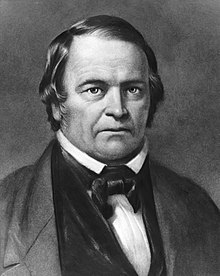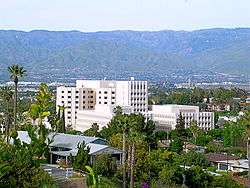Seventh-day Adventist Church
The Seventh-day Adventist Church[lower-alpha 1] is a Protestant Christian denomination[3] which is distinguished by its observance of Saturday,[4] the seventh day of the week in Christian and Jewish calendars, as the Sabbath, and its emphasis on the imminent Second Coming (advent) of Jesus Christ. The denomination grew out of the Millerite movement in the United States during the mid-19th century and it was formally established in 1863.[5] Among its founders was Ellen G. White, whose extensive writings are still held in high regard by the church.[6] Much of the theology of the Seventh-day Adventist Church corresponds to common evangelical Christian teachings, such as the Trinity and the infallibility of Scripture. Distinctive teachings include the unconscious state of the dead and the doctrine of an investigative judgment. The church is known for its emphasis on diet and health, including adhering to Kosher food laws, advocating vegetarianism, and its holistic understanding of the person.[7][8] It is likewise known for its promotion of religious liberty, and its conservative principles and lifestyle.[9]
| Seventh-day Adventist Church | |
|---|---|
 The Seventh-day Adventist logo | |
| Classification | Protestant |
| Orientation | Adventist |
| Theology | Arminianism, Seventh-day Adventist theology |
| Polity | Polity of the Seventh-day Adventist Church |
| President | Ted N. C. Wilson |
| Region | Worldwide |
| Founder |
|
| Origin | 21 May 1863 Battle Creek, Michigan, U.S. |
| Branched from | Millerites |
| Separations |
|
| Congregations | 86,576 churches, 71,758 companies |
| Members | 21,414,779[1] |
| Pastors | 19,717[2] |
| Hospitals | 198[2] |
| Nursing homes | 133[2] |
| Aid organization | Adventist Development and Relief Agency |
| Primary schools | 5,915[2] |
| Secondary schools | 2,435[2] |
| Tertiary institutions | 115[2] |
| Other name(s) | Adventist church, SDA (informal) |
| Official website | www |
| Part of a series on |
| Seventh-day Adventist Church |
|---|
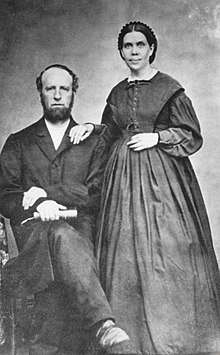 |
|
|
|
Organization Divisions
|
|
| Adventism |
The world church is governed by a General Conference of Seventh-day Adventists, with smaller regions administered by divisions, union conferences, and local conferences. It currently has a worldwide baptized membership of over 20 million people, and 25 million adherents.[10][11] As of May 2007, it was the twelfth-largest religious body in the world, and the sixth-largest highly international religious body. It is ethnically and culturally diverse, and maintains a missionary presence in over 215 countries and territories.[2][12] The church operates over 7,500 schools including over 100 post-secondary institutions, numerous hospitals, and publishing houses worldwide, as well as a humanitarian aid organization known as the Adventist Development and Relief Agency (ADRA).
History
The Seventh-day Adventist Church is the largest of several Adventist groups which arose from the Millerite movement of the 1840s in upstate New York, a phase of the Second Great Awakening. William Miller predicted on the basis of Daniel 8:14–16 and the "day-year principle" that Jesus Christ would return to Earth between the spring of 1843 and the spring of 1844. In the summer of 1844, Millerites came to believe that Jesus would return on October 22, 1844, understood to be the biblical Day of Atonement for that year. Miller's failed prediction became known as the "Great Disappointment".
Hiram Edson and other Millerites came to believe that Miller's calculations were correct, but that his interpretation of Daniel 8:14 was flawed as he assumed Christ would come to cleanse the world. These Adventists came to the conviction that Daniel 8:14 foretold Christ's entrance into the Most Holy Place of the heavenly sanctuary rather than his Second Coming. Over the next few decades this understanding of a sanctuary in heaven developed into the doctrine of the investigative judgment, an eschatological process that commenced in 1844, in which every person would be judged to verify their eligibility for salvation and God's justice will be confirmed before the universe. This group of Adventists continued to believe that Christ's Second Coming would continue to be imminent, however they resisted setting further dates for the event, citing Revelation 10:6, "that there should be time no longer."[13]
Development of Sabbatarianism
As the early Adventist movement consolidated its beliefs, the question of the biblical day of rest and worship was raised. The foremost proponent of Sabbath-keeping among early Adventists was Joseph Bates. Bates was introduced to the Sabbath doctrine through a tract written by Millerite preacher Thomas M. Preble, who in turn had been influenced by Rachel Oakes Preston, a young Seventh Day Baptist. This message was gradually accepted and formed the topic of the first edition of the church publication The Present Truth (now the Adventist Review), which appeared in July 1849.[14]
Organization and recognition
For about 20 years, the Adventist movement consisted of a small, loosely knit group of people who came from many churches and whose primary means of connection and interaction was through James White's periodical The Advent Review and Sabbath Herald. They embraced the doctrines of the Sabbath, the heavenly sanctuary interpretation of Daniel 8:14, conditional immortality, and the expectation of Christ's premillennial return. Among its most prominent figures were Joseph Bates, James White, and Ellen G. White. Ellen White came to occupy a particularly central role; her many visions and spiritual leadership convinced her fellow Adventists that she possessed the gift of prophecy.
The church was formally established in Battle Creek, Michigan, on May 21, 1863, with a membership of 3,500.[5] The denominational headquarters were later moved from Battle Creek to Takoma Park, Maryland, where they remained until 1989. The General Conference headquarters then moved to its current location in Silver Spring, Maryland.[15]
The denomination in the 1870s turned to missionary work and revivals, tripling its membership to 16,000 by 1880 and establishing a presence beyond North America during the late 19th century. Rapid growth continued, with 75,000 members in 1901. By this time the denomination operated two colleges, a medical school, a dozen academies, 27 hospitals, and 13 publishing houses. By 1945, the church reported 210,000 members in the US and Canada, and 360,000 elsewhere; the budget was $29 million and enrollment in church schools was 140,000.[16]
The church's beliefs and doctrines were first published in 1872 in Battle Creek Michigan as a brief statement called "A Synopsis of our Faith".[17] The church experienced challenges as it formed its core beliefs and doctrines especially as a number of the early Adventist leaders came from churches that held to some form of Arianism (Ellen G. White was not one of them).[18] This, along with some of the movement's other theological views, led to a consensus among conservative evangelical Protestants to regard it as a cult.[19][20][21][22] According to Adventist scholars,[23] the teachings and writings of White, ultimately proved influential in shifting the church from largely semi-Arian[24] roots towards Trinitarianism.[25] Adventists, for the most part, credit her with bringing the Seventh-day Adventist church into a more comprehensive awareness of the GodHead during the 1890s. The Adventist Church adopted Trinitarian theology early in the 20th century and began to dialogue with other Protestant groups toward the middle of the century, eventually gaining wide recognition as a Protestant church. Christianity Today recognized the Seventh-day Adventist church as " the fifth-largest Christian communion worldwide" in its January 22, 2015 issue.[26]
Ellen White avoided using the word "Trinity", "and her husband stated categorically that her visions did not support the Trinitarian creed."[27] Her theology did not include a doctrine of the Trinity.[28] Through continued Bible study, and decades-long debate, the denomination eventually concluded that Scripture does explicitly teach the existence of a triune God and affirm that biblical view in the non-credal 28 Fundamental Beliefs.[29]
Beliefs
The official teachings of the Seventh-day Adventist denomination are expressed in its 28 Fundamental Beliefs. This statement of beliefs was originally adopted by the General Conference in 1980, with an additional belief (number 11) being added in 2005.[30] Acceptance of either of the church's two baptismal vows is a prerequisite for membership.
Adventist doctrine resembles trinitarian Protestant theology, with premillennial and Arminian emphases. Adventists uphold teachings such as the infallibility of Scripture, the substitutionary atonement, the resurrection of the dead and justification by faith alone, and are therefore considered evangelical.[31] They believe in baptism by immersion and creation in six literal days. The modern Creationist movement started with Adventist George McCready Price, who was inspired by a vision of Ellen White.[32]
There is a generally recognized set of "distinctive" doctrines which distinguish Adventism from the rest of the Christian world, although not all of these teachings are wholly unique to Adventism:[33]
- Law (fundamental belief 19): the Law of God is "embodied in the Ten Commandments", which continue to be binding upon Christians.
- Sabbath (fundamental belief 20): the Sabbath should be observed on the seventh day of the week, specifically, from Friday sunset to Saturday sunset.
- Second Coming and End times (fundamental beliefs 25–28): Jesus Christ will return visibly to earth after a "time of trouble", during which the Sabbath will become a worldwide test. The Second Coming will be followed by a millennial reign of the saints in heaven. Adventist eschatology is based on the historicist method of prophetic interpretation.
- Holistic human nature (fundamental beliefs 7, 26): Humans are an indivisible unity of body, mind, and spirit. They do not possess an immortal soul and there is no consciousness after death (commonly referred to as "soul sleep"). (See also: Christian anthropology)
- Conditional immortality (fundamental belief 27): The wicked will not suffer eternal torment in hell, but instead will be permanently destroyed. (See: Conditional immortality, Annihilationism)
- Great Controversy (fundamental belief 8): Humanity is involved in a "great controversy" between Jesus Christ and Satan. This is an elaboration on the common Christian belief that evil began in heaven when an angelic being (Lucifer) rebelled against the Law of God.
- Heavenly sanctuary (fundamental belief 24): At his ascension, Jesus Christ commenced an atoning ministry in the heavenly sanctuary. In 1844, he began to cleanse the heavenly sanctuary in fulfillment of the Day of Atonement.
- Investigative Judgment (fundamental belief 24): A judgment of professed Christians began in 1844, in which the books of record are examined for all the universe to see. The investigative judgment will affirm who will receive salvation, and vindicate God in the eyes of the universe as just in his dealings with mankind.
- Remnant (fundamental belief 13): There will be an end-time remnant who keep the commandments of God and have "the testimony of Jesus".[34] This remnant proclaims the "three angels' messages" of Revelation 14:6–12 to the world.
- Spirit of Prophecy (fundamental belief 18): The ministry of Ellen G. White is commonly referred to as the "Spirit of Prophecy" and her writings "speak with prophetic authority and provide comfort, guidance, instruction, and correction to the church.",[35] though ultimately subject to the Bible. (See: Inspiration of Ellen White.)
Theological spectrum
As with any religious movement, a theological spectrum exists within Adventism comparable to the fundamentalist-moderate-liberal spectrum in the wider Christian church as well as in other religions. A variety of groups, movements and subcultures within the church present differing views on beliefs and lifestyle.
The conservative end of the theological spectrum is represented by historic Adventists, who are characterized by their opposition to theological trends within the denomination, beginning in the 1950s.[36] They object to theological compromises with Evangelicalism, and seek to defend traditional Adventist teachings such as the human post-fall nature of Jesus Christ, investigative judgment, and character perfectionism.[37] Historic Adventism is represented by some scholars,[38] is also seen at the grassroots level of the church[39] and is often promoted through independent ministries.
The most liberal elements in the church are typically known as progressive Adventists (progressive Adventists generally do not identify with liberal Christianity). They tend to disagree with the traditional views concerning the inspiration of Ellen White, the Sabbath, a seven-day Creation, the doctrine of the remnant and the investigative judgment.[37][40] The progressive movement is supported by some scholars[41] and finds expression in bodies such as the Association of Adventist Forums and in journals such as Spectrum and Adventist Today.
Theological organizations
The Biblical Research Institute is the official theological research center of the church. The church has two professional organizations for Adventist theologians who are affiliated with the denomination. The Adventist Society for Religious Studies (ASRS) was formed to foster a community among Adventist theologians who attend the Society of Biblical Literature (SBL) and the American Academy of Religion. In 2006, ASRS voted to continue their meetings in the future in conjunction with SBL. During the 1980s, the Adventist Theological Society was formed to provide a forum for more conservative theologians to meet and is held in conjunction with the Evangelical Theological Society.[42]
Culture and practices
Sabbath activities
Part of Friday might be spent in preparation for the Sabbath; for example, preparing meals and tidying homes. Adventists may gather for Friday evening worship to welcome in the Sabbath, a practice often known as Vespers.[43]
Adventists abstain from secular work on Saturday. They will also usually refrain from purely secular forms of recreation, such as competitive sport and watching non-religious programs on television. However, nature walks, family-oriented activities, charitable work and other activities that are compassionate in nature are encouraged. Saturday afternoon activities vary widely depending on the cultural, ethnic and social background. In some churches, members and visitors will participate in a fellowship (or "potluck") lunch and AYS (Adventist Youth Service).
Worship service
The major weekly worship service occurs on Saturday, typically commencing with Sabbath School which is a structured time of small-group bible study at church. Adventists make use of an officially produced "Sabbath School Lesson", which deals with a particular biblical text or doctrine every quarter.[44] Special meetings are provided for children and youth in different age groups during this time (analogous to Sunday school in other churches).
After a brief break, the community joins together again for a church service that follows a typical evangelical format, with a sermon as a central feature. Corporate singing, Scripture readings, prayers and an offering, including tithing (or money collection), are other standard features. The instruments and forms of worship music vary greatly throughout the worldwide church.[45] Some churches in North America have a contemporary Christian music style, whereas other churches enjoy more traditional hymns including those found in the Adventist Hymnal. Worship is known to be generally restrained.
Holy Communion
Adventist churches usually practice open communion four times a year. It commences with a foot washing ceremony, known as the "Ordinance of Humility", based on the Gospel account of John 13. The Ordinance of Humility is meant to emulate Christ's washing of his disciples' feet at the Last Supper and to remind participants of the need to humbly serve one another. Participants segregate by gender to separate rooms to conduct this ritual, although some congregations allow married couples to perform the ordinance on each other and families are often encouraged to participate together. After its completion, participants return to the main sanctuary for consumption of the Lord's Supper, which consists of unleavened bread and unfermented grape juice.[46]
Health and diet
Since the 1860s when the church began, wholeness and health have been an emphasis of the Adventist church.[47] Adventists are known for presenting a "health message" that advocates vegetarianism and expects adherence to the kosher laws,[48] particularly the consumption of kosher foods described in Leviticus 11, meaning abstinence from pork, shellfish, and other animals proscribed as "unclean".
The church discourages its members from consuming alcoholic beverages, tobacco or illegal drugs (compare Christianity and alcohol). In addition, some Adventists avoid coffee, tea, cola, and other beverages that contain caffeine.

The pioneers of the Adventist Church had much to do with the common acceptance of breakfast cereals into the Western diet, and the "modern commercial concept of cereal food" originated among Adventists.[49] John Harvey Kellogg was one of the early founders of Adventist health work. His development of breakfast cereals as a health food led to the founding of Kellogg's by his brother William. He advertised bland corn flakes as a way to curb sexual desire and avoid the evils of masturbation. In both Australia and New Zealand, the church-owned Sanitarium Health and Wellbeing Company is a leading manufacturer of health and vegetarian-related products, most prominently Weet-Bix.
Research funded by the U.S. National Institutes of Health has shown that the average Adventist in California lives 4 to 10 years longer than the average Californian. The research, as cited by the cover story of the November 2005 issue of National Geographic, asserts that Adventists live longer because they do not smoke or drink alcohol, have a day of rest every week, and maintain a healthy, low-fat vegetarian diet that is rich in nuts and beans.[50][51] The cohesiveness of Adventists' social networks has also been put forward as an explanation for their extended lifespan.[52] Since Dan Buettner's 2005 National Geographic story about Adventist longevity, his book, The Blue Zones: Lessons for Living Longer From the People Who've Lived the Longest, named Loma Linda, California a "Blue Zone" because of the large concentration of Seventh-day Adventists. He cites the Adventist emphasis on health, diet, and Sabbath-keeping as primary factors for Adventist longevity.[53][54]
An estimated 35% of Adventists practice vegetarianism or veganism, according to a 2002 worldwide survey of local church leaders.[55][56]
Adventists' clean lifestyles were recognized by the U.S. military in 1954 when 2,200 Adventists volunteered to serve as human test subjects in Operation Whitecoat, a biodefense medical research program whose stated purpose was to defend troops and civilians against biological weapons:
The first task of the scientists was to find people who were willing to be infected by pathogens that could make them very sick. They found them in the followers of the Seventh-day Adventist faith. Although willing to serve their country when drafted, the Adventists refused to bear arms. As a result many of them became medics. Now the U.S. was offering recruits an opportunity to help in a different manner: to volunteer for biological tests as a way of satisfying their military obligations. When contacted in late 1954, the Adventist hierarchy readily agreed to this plan. For Camp Detrick scientists, church members were a model test population, since most of them were in excellent health and they neither drank, smoked, nor used caffeine. From the perspective of the volunteers, the tests gave them a way to fulfill their patriotic duty while remaining true to their beliefs.[57]
Marriage
The Adventist understanding of marriage is a lawfully binding lifelong commitment of a man and a woman. The Church Manual refers to the origination of the marriage institution in Eden and points to the union between Adam and Eve as the pattern for all future marriages.[58]
Adventists hold that marriage is a divine institution established by God Himself before the fall. "Therefore shall a man leave his father and his mother, and shall cleave unto his wife: and they shall be one flesh." (Gen. 2:24). They hold that God celebrated the first marriage and the institution has as its origin the Creator of the universe and was one of the first gifts of God to man, and it is "one of the two institutions that, after the fall, Adam brought with him beyond the gates of Paradise."[59]
The Old and New Testament texts are interpreted by some Adventists to teach that wives should submit to their husbands in marriage.[60]
Adventists hold that heterosexual marriages are the only biblically ordained grounds for sexual intimacy. Adventists do not perform same-sex marriages, and individuals who are openly homosexual cannot be ordained, but may hold church office and membership if they are not actively pursuing same-sex relationships. Current church policy states that openly homosexual (and "practicing") persons are to be welcomed into the church services and treated with the love and kindness afforded any human being.[61][62]
Ethics and sexuality
The Seventh-day Adventist Church considers abortion out of harmony with God's plan for human life. It affects the unborn, the mother, the father, immediate and extended family members, the church family, and society with long-term consequences for all. In an official statement on the "Biblical View of Unborn Life", the Church states that 1. God upholds the value and sacredness of human life, 2. God considers the unborn child as human life, 3. The will of God regarding human life is expressed in the Ten Commandments and explained by Jesus in the Sermon on the Mount, 4. God is the Owner of life, and human beings are His stewards, 5. The Bible teaches care for the weak and the vulnerable, and 6. God's grace promotes life in a world marred by sin and death.[63]
Adventists believe in and encourage abstinence for both men and women before marriage. The church disapproves of extra-marital cohabitation.[64] Adventists believe that scripture makes no accommodation for homosexual activity or relationships, and its official position is opposed to it.[65]
The Adventist church has released official statements in relation to other ethical issues such as euthanasia (against active euthanasia but permissive of passive withdrawal of medical support to allow death to occur),[66] birth control (in favor of it for married couples if used correctly, but against abortion as birth control and premarital sex in any case)[67] and human cloning (against it while the technology is unsafe and would result in defective births or abortions).[68]
Dress and entertainment
Adventists have traditionally held socially conservative attitudes regarding dress and entertainment. These attitudes are reflected in one of the church's fundamental beliefs:
For the Spirit to recreate in us the character of our Lord we involve ourselves only in those things which will produce Christlike purity, health, and joy in our lives. This means that our amusement and entertainment should meet the highest standards of Christian taste and beauty. While recognizing cultural differences, our dress is to be simple, modest, and neat, befitting those whose true beauty does not consist of outward adornment but in the imperishable ornament of a gentle and quiet spirit.[35]
Accordingly, many Adventists are opposed to practices such as body piercing and tattoos and refrain from the wearing of jewelry, including such items as earrings and bracelets. Some also oppose the displaying of wedding bands, although banning wedding bands is not the position of the General Conference.[69] Conservative Adventists avoid certain recreational activities which are considered to be a negative spiritual influence, including dancing, rock music and secular theatre.[70][71] However, major studies conducted from 1989 onwards found that a majority of North American church youth reject some of these standards.[72]
Though it seems unbelievable to some, I'm thankful that when I grew up in the church [in the 1950s and 1960s] I was taught not to go to the movie theater, dance, listen to popular music, read novels, wear jewelry, play cards, bowl, play pool, or even be fascinated by professional sports.
Adventists often cite the writings of Ellen White, especially her books, Counsels on Diet and Foods, Counsels to Parents, Teachers and Students, and Education as inspired sources for Christian deportment. The Adventist church officially opposes the practice of gambling.[74]
Missionary work with youth
The Youth Department of the Adventist church runs age specific clubs for children and youth worldwide.
"Adventurer" (grades 1-4), "Eager Beaver" (Kindergarten), and "Little Lambs" (pre-K) clubs are programs for younger children that feed into the Pathfinder program.
Pathfinders is a club for 5th to 10th grade (up to 12th in Florida Conference) boys and girls. It is similar to and based partly on the Scouting movement. Pathfinders exposes young people to such activities as camping, community service, personal mentorship, and skills-based education, and trains them for leadership in the church. Yearly "Camporees" are held in individual Conferences, where Pathfinders from the region gather and participate in events similar to Boy Scouts' Jamborees.
After a person enters 9th grade, he or she is eligible to join Teen Leadership Training within Pathfinders. In the 11th grade, typically after being a member of a club, they can become a Pathfinder or Adventurer staff member and begin the "Master Guide" program (similar to Scout Master) which develops leaders for both Adventurers and Pathfinders.[75]
Youth camps
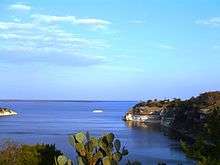
The Seventh-day Adventist Church operates youth camps all over North America and many other parts of the world. Each camp varies in the activities they offer but most have archery, swimming, horses, arts and crafts, nature, high ropes challenge course, and many other common camp activities. In addition to regular camps some have specialty camps, or RAD camps, which vary in their activities such as a week of nature nuggets, surfing, waterskiing/wakeboarding, rock climbing, golf, skateboarding, whitewater rafting, mountain biking, cycling, or basketball.
Organization
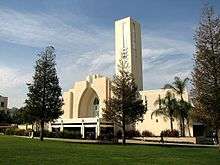
Structure and polity
The Seventh-day Adventist church is governed by a form of representation which resembles the presbyterian system of church organization. Four levels of organization exist within the world church.[76][77]
- The local church is the foundation level of organizational structure and is the public face of the denomination. Every baptized Adventist is a member of a local church and has voting powers within that church.
- Directly above the local church is the "local conference" . The local conference is an organization of churches within a state, province or territory (or part thereof) which appoints ministers, owns church land and organizes the distribution of tithes and payments to ministers.
- Above the local conference is the "union conference" which embodies a number of local conferences within a larger territory.
- The highest level of governance within the church structure is the General Conference which consists of 13 "Divisions", each assigned to various geographic locations. The General Conference is the church authority and has the final say in matters of conjecture and administrative issues. The General Conference is headed by the office of President. The General Conference head office is in Silver Spring, Maryland, United States.
Each organization is governed by a general "session" which occurs at certain intervals. This is usually when administrative decisions are made. The president of the General Conference, for instance, is elected at the General Conference Session every five years. Delegates to a session are appointed by organizations at a lower level. For example, each local church appoints delegates to a conference session.
Tithes collected from church members are not used directly by the local churches, but are passed upwards to the local conferences which then distribute the finances toward various ministry needs. Employees are compensated "on the basis of the church remuneration policy and practice in effect in the location or country in which they reside."[78]
The Church Manual[76] gives provisions for each level of government to create educational, healthcare, publishing, and other institutions that are seen within the call of the Great Commission.
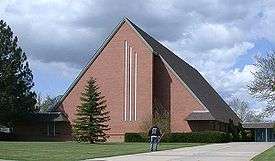
Church officers and clergy
The ordained clergy of the Adventist church are known as ministers or pastors. Ministers are neither elected nor employed by the local churches, but instead are appointed by the local Conferences, which assign them responsibility over a single church or group of churches. Ordination is a formal recognition bestowed upon pastors and elders after usually a number of years of service. In most parts of the world, women may not be given the title "ordained", although some are employed in ministry, and may be "commissioned" or "ordained-commissioned".[79] However, beginning in 2012, some unions adopted policies of allowing member conferences to ordain without regard to gender.
A number of lay offices exist within the local church, including the ordained positions of elder and deacon.[76] Elders and deacons are appointed by the vote of a local church business meeting or elected committees. Elders serve a mainly administrative and pastoral role, but must also be capable of providing religious leadership (particularly in the absence of an ordained minister). The role of deacons is to assist in the smooth functioning of a local church and to maintain church property.
Ordination of women
Although the church has no written policy forbidding the ordination of women, it has traditionally ordained only men. In recent years the ordination of women has been the subject of heated debate, especially in North America and Europe. In the Adventist church, candidates for ordination are chosen by local conferences (which usually administer about 50–150 local congregations) and approved by unions (which serve about 6–12 conferences). The General Conference, the church's world headquarters, claims the right to declare the worldwide qualifications for ordination, including gender requirements. The General Conference has never stated that ordination of women contravenes the Bible, but the General Conference has requested that no local conference ordain women until all parts of the world church accept the practice.[80]
Membership


The primary prerequisite for membership in the Adventist church is baptism by immersion. This, according to the church manual, should occur only after the candidate has undergone proper instruction on what the church believes.[76]
As of December 31, 2016, the church has 20,008,779 baptized members.[2] Between 2005 and 2015, around half a million people per year have joined the Adventist church, through baptisms and professions of faith.[2][81] The church is one of the world's fastest-growing organizations, primarily from membership increases in developing nations. Today, less than 7% of the world membership reside in the United States, with large numbers in Africa as well as Central and South America. Depending on how the data was measured, it is reported that church membership reached 1 million between 1955 and 1961, and grew to five million in 1986. At the turn of the 21st century the church had over 10 million members, which grew to over 14 million in 2005, 16 million in 2009, and 19 million in 2015.[82] It is reported that today over 25 million people worship weekly in Seventh-day Adventist churches worldwide.[83] The church operates in 202 out of 230 countries and areas recognized by the United Nations,[2] making it "probably the most widespread Protestant denomination".[84]
G. Jeffrey MacDonald, an award-winning religion reporter, and author of Thieves in the Temple, reports that the SDA church is the fastest-growing church in the United States. "Newly released data show Seventh-day Adventism growing by 2.5% in North America, a rapid clip for this part of the world, where Southern Baptists and mainline denominations, as well as other church groups, are declining."[85]
The church has been described as "something of an extended family",[86] enjoying close, "two-degrees-of-separation social networks".[87]
Church institutions
The Biblical Research Institute is the theological research center of the church.
The Ellen G. White Estate was established in 1915 at the death of Ellen White, as specified in her legal will. Its purpose is to act as custodian of her writings, and as of 2006 it has 15 board members. The Ellen G. White Estate also hosts the official Ellen White website whiteestate.org.
The Geoscience Research Institute, based at Loma Linda University, was founded in 1958 to investigate the scientific evidence concerning origins.
Adventist mission
Started in the late 19th century, Adventist mission work today reaches people in over 200 countries and territories.[2] Adventist mission workers seek to preach the gospel, promote health through hospitals and clinics, run development projects to improve living standards, and provide relief in times of calamity.[88]
Missionary outreach of the Seventh-day Adventist Church is aimed not only at non-Christians but also at Christians from other denominations. Adventists believe that Christ has called his followers in the Great Commission to reach the whole world. Adventists are cautious, however, to ensure that evangelism does not impede or intrude on the basic rights of the individual. Religious liberty is a stance that the Adventist Church supports and promotes.[89]
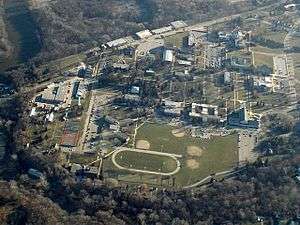
Education
Globally, the Adventist Church operates 7,598 schools, colleges and universities, with a total enrollment of more than 1,545,000 and a total teaching staff of approximately 80,000.[90] It claims to operate "one of the largest church-supported educational systems in the world".[91] In the United States it operates the largest Protestant educational system, second overall only to that of the Roman Catholic Church.[92] The Adventist educational program strives to be comprehensive, encompassing "mental, physical, social and above all, spiritual health" with "intellectual growth and service to humanity" as its goal.
The largest (in terms of population) Seventh-day Adventist university in the world is Northern Caribbean University, located in Mandeville, Jamaica.
Health
Adventists run a large number of hospitals and health-related institutions. Their largest medical school and hospital in North America is Loma Linda University and its attached Medical Center. Throughout the world, the church runs a wide network of hospitals, clinics, lifestyle centers, and sanitariums. These play a role in the church's health message and worldwide missions outreach.[93]
Adventist Health System is the largest not-for-profit multi-institutional Protestant healthcare system in the United States. It is sponsored by the Seventh-day Adventist Church and cares for over 4 million patients yearly.
Humanitarian aid and the environment
For over 50 years, the church has been active in humanitarian aid through the work of the Adventist Development and Relief Agency (ADRA). ADRA works as a non-sectarian relief agency in 125 countries and areas of the world. ADRA has been granted General Consultative Status by the United Nations Economic and Social Council. Worldwide, ADRA employs over 4,000 people to help provide relief in crises as well as development in situations of poverty.
The church embraces an official commitment to the protection and care of the environment[94] as well as taking action to avoid the dangers of climate change:[95] "Seventh-day Adventism advocates a simple, wholesome lifestyle, where people do not step on the treadmill of unbridled over-consumption, accumulation of goods, and production of waste. A reformation of lifestyle is called for, based on respect for nature, restraint in the use of the world's resources, reevaluation of one's needs, and reaffirmation of the dignity of created life."[96]
Religious liberty
For over 120 years, The Adventist church has actively promoted freedom of religion for all people regardless of faith. In 1893, its leaders founded the International Religious Liberty Association, which is universal and non-sectarian. The Seventh-day Adventist Church State Council serves, primarily through advocacy, to seek protection for religious groups from legislation that may affect their religious practices. In May 2011, for example, the organization fought to pass legislation that would protect Adventist employees who wish to keep the Sabbath. According to Americans United for Separation of Church and State, the Seventh-day Adventist Church has, throughout its history, aggressively advocated for the separation of church and state.[97]
Media

Adventists have long been proponents of media-based ministries. Traditional Adventist evangelistic efforts consisted of street missions and the distribution of tracts such as The Present Truth, which was published by James White as early as 1849. Until J. N. Andrews was sent to Switzerland in 1874, Adventist global efforts consisted entirely of the posting of tracts such as White's to various locations.
In the last century, these efforts have also made use of emerging media such as radio and television. The first of these was H. M. S. Richards' radio show Voice of Prophecy, which was initially broadcast in Los Angeles in 1929. Since then, Adventists have been on the forefront of media evangelism; It Is Written, founded by George Vandeman, was the first religious program to air on color television and the first major Christian ministry to utilize satellite uplink technology. Today the Hope Channel, the official television network of the church, operates 8+ international channels broadcasting 24 hours a day on cable, satellite, and the Web.[98]
Adventist World Radio was founded in 1971[99] and is the "radio mission arm" of the Seventh-day Adventist Church. It utilizes AM, FM, shortwave, satellite, podcasting, and the Internet, broadcasting in 77 major language groups of the world with a potential coverage of 80% of the world's population. AWR's headquarters is in Silver Spring, Maryland, with studios throughout the world. A large portion of the ministry's income is derived from membership gifts.[100]
SDA evangelists such as Doug Batchelor, Mark Finley and Dwight Nelson have undertaken a number of international satellite-broadcast live evangelistic events, addressing audiences in up to 40 languages simultaneously.[101]
Additionally, there exists a range of privately owned media entities representing Adventist beliefs. These include the Three Angels Broadcasting Network (3ABN) and SafeTV networks and organizations such as The Quiet Hour and Amazing Discoveries.
In 2016, the Church released the film Tell the World.[102]
Publishing
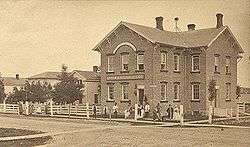
The Adventist Church owns and operates many publishing companies around the world. Two of the largest are the Pacific Press and Review and Herald publishing associations, both located in the United States. The Review and Herald is headquartered in Hagerstown, Maryland.[103]
The official church magazine is the Adventist Review, which has a North American focus. It has a sister magazine (Adventist World), which has an international perspective. Another major magazine published by the church is the bimonthly Liberty magazine, which addresses issues pertaining to religious freedom.
Ecumenical activity
The Adventist Church generally opposes the ecumenical movement, although it supports some of the other goals of ecumenism. The General Conference has released an official statement concerning the Adventist position with respect to the ecumenical movement, which contains the following paragraph:
- "Should Adventists cooperate ecumenically? Adventists should cooperate insofar as the authentic gospel is proclaimed and crying human needs are being met. The Seventh-day Adventist Church wants no entangling memberships and refuses any compromising relationships that might tend to water down her distinct witness. However, Adventists wish to be "conscientious cooperators." The ecumenical movement as an agency of cooperation has acceptable aspects; as an agency for the organic unity of churches, it is much more suspect."[104]
While not being a member of the World Council of Churches, the Adventist Church has participated in its assemblies in an observer capacity.[105]
Criticism
The Adventist Church has received criticism along several lines, including what some claim are heterodox doctrines, and in relation to Ellen G. White and her status within the church, and in relation to alleged exclusivist issues.[106]
Doctrines
Critics such as evangelical Anthony Hoekema (who felt that Adventists were more in agreement with Arminianism) argue that some Adventist doctrines are heterodox. Several teachings which have come under scrutiny are the annihilationist view of hell, the investigative judgment (and a related view of the atonement), and the Sabbath; in addition, Hoekema also claims that Adventist doctrine suffers from legalism.[107]
While critics such as Hoekema have classified Adventism as a sectarian group on the basis of its atypical doctrines,[19][20] it has been accepted as more mainstream by Protestant evangelicals since its meetings and discussions with evangelicals in the 1950s.[108] Notably, Billy Graham invited Adventists to be part of his crusades after Eternity, a conservative Christian magazine edited by Donald Barnhouse, asserted in 1956 that Adventists are Christians, and also later stated, "They are sound on the great New Testament doctrines including grace and redemption through the vicarious offering of Jesus Christ 'once for all'".[109] Walter Martin, who is considered by many to be the father of the counter-cult apologetics movement within evangelicalism, authored The Truth About Seventh-day Adventists (1960) which marked a turning point in the way Adventism was viewed.[110][111]
... it is perfectly possible to be a Seventh-day Adventist and be a true follower of Jesus Christ despite heterodox concepts ...
Later on, Martin planned to write a new book on Seventh-day Adventism, with the assistance of Kenneth R. Samples.[113] Samples subsequently authored "From Controversy to Crisis: An Updated Assessment of Seventh-day Adventism", which upholds Martin's view "for that segment of Adventism which holds to the position stated in QOD, and further expressed in the Evangelical Adventist movement of the last few decades." However, Samples also claimed that "Traditional Adventism" appeared "to be moving further away from a number of positions taken in QOD", and at least at Glacier View seemed to have "gained the support of many administrators and leaders".[114]
Ellen G. White and her status
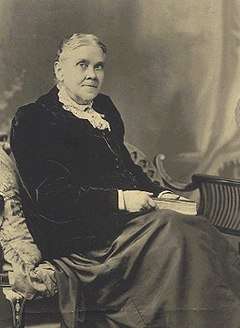
Ellen G. White's status as a modern-day prophet has also been criticized. In the Questions on Doctrine era, evangelicals expressed concern about Adventism's understanding of the relationship of White's writings to the inspired canon of Scripture.[19] The Adventist fundamental beliefs maintain that "the Bible is the standard by which all teaching and experience must be tested."[115]
A common criticism of Ellen White, widely popularized by Walter T. Rea, Ronald Numbers and others, is the claim of plagiarism from other authors.[116][117][118] An independent lawyer specializing in plagiarism, Vincent L. Ramik, was engaged to undertake a study of Ellen G. White's writings during the early 1980s, and concluded that they were "conclusively unplagiaristic".[119] When the plagiarism charge ignited a significant debate during the late 1970s and early 1980s, the Adventist General Conference commissioned a major study by Dr. Fred Veltman. The ensuing project became known as the "'Life of Christ' Research Project". The results are available at the General Conference Archives.[120] Dr. Roger W. Coon,[121] David J. Conklin,[122] Dr. Denis Fortin,[123][124] King and Morgan,[125] and Morgan,[126] among others, undertook the refutation of the accusations of plagiarism. At the conclusion of his report, Ramik states:
It is impossible to imagine that the intention of Ellen G. White, as reflected in her writings and the unquestionably prodigious efforts involved therein, was anything other than a sincerely motivated and unselfish effort to place the understandings of Biblical truths in a coherent form for all to see and comprehend. Most certainly, the nature and content of her writings had but one hope and intent, namely, the furthering of mankind's understanding of the word of God. Considering all factors necessary in reaching a just conclusion on this issue, it is submitted that the writings of Ellen G. White were conclusively unplagiaristic.[127]
Exclusivism
Critics have alleged that certain Adventist beliefs and practices are exclusivist in nature and they point to the Adventist claim to be the "remnant church", and the traditional Protestant association of Roman Catholicism with "Babylon".[128][129][130] These attitudes are said to legitimize the proselytising of Christians from other denominations. In response to such criticisms, Adventist theologians have stated that the doctrine of the remnant does not preclude the existence of genuine Christians in other denominations, but is concerned with institutions.[131]
We fully recognize the heartening fact that a host of true followers of Christ are scattered all through the various churches of Christendom, including the Roman Catholic communion. These God clearly recognizes as His own. Such do not form a part of the "Babylon" portrayed in the Apocalypse.
— Questions on Doctrine, p. 197.
Ellen White also presented it in a similar light:
God has children, many of them, in the Protestant churches, and a large number in the Catholic churches, who are more true to obey the light and to do [to] the very best of their knowledge than a large number among Sabbathkeeping Adventists who do not walk in the light.
— Ellen White, Selected Messages, book 3, p.386.
Independent ministries, offshoots, and schisms
Independent ministries
In addition to the ministries and institutions which are formally administered by the denomination, numerous para-church organizations and independent ministries exist. These include various health centers and hospitals, publishing and media ministries, and aid organizations. Present Truth Magazine is an independent online magazine for those claiming to be "evangelical" Adventists.
A number of independent ministries have been established by groups within the Adventist church who hold a theologically distinct position or wish to promote a specific message, such as Hope International which have strained relationship with the official church, which has expressed concerns that such ministries may threaten Adventist unity.[132] Some independent ministries, like many of the Protestant reformers have continued to emphasize the mainstream Adventist belief which identified the Roman Papacy as the Antichrist.[133] The church has put out a statement clarifying the official position that it does not condone any behavior by members which may "have manifested prejudice and even bigotry" against Catholics.[134]
Offshoots and schisms
Throughout the history of the denomination, there have been a number of groups which have left the church and formed their own movements.
Following World War I, a group known as the Seventh Day Adventist Reform Movement was formed as a result of the actions of L. R. Conradi and certain European church leaders during the war, who decided that it was acceptable for Adventists to take part in war. Those who were opposed to this stand and refused to participate in the war were declared "disfellowshipped" by their local Church leaders at the time. When the Church leaders from the General Conference came and admonished the local European leaders after the war to try to heal the damage, and bring the members together, it met with resistance from those who had suffered under those leaders. Their attempts at reconciliation failed after the war and the group became organized as a separate church at a conference that was held on July 14–20, 1925. The movement officially incorporated in 1949.[135]
In 2005, in another attempt to examine and resolve what its German leaders had done, the mainstream church apologized for its failures during World War II, stating, we "'deeply regret' any participation in or support of Nazi activities during the war by the German and Austrian leadership of the church."[136]
In the Soviet Union the same issues produced the group known as the True and Free Seventh-day Adventists. This formed as the result of a schism within the Seventh-day Adventist Church in Europe during World War I over the position its European church leaders took on having its members join the military or keep the Sabbath. The group remains active today (2010) in the former republics of the Soviet Union.[137]
Well known but distant offshoots are the Davidian Seventh-day Adventist organization and the Branch Davidians, themselves a schism within the larger Davidian movement.[138] The Davidians formed in 1929, following Victor Houteff after he came out with his book The Shepherd's Rod which was rejected as heretical. A succession dispute after Houteff's death in 1955 led to the formation of two groups, the original Davidians and the Branches. Later, another ex-Adventist, David Koresh, led the Branch Davidians until he died in the 1993 siege at the group's headquarters near Waco, Texas.
A number of Adventists who apostatized, such as former ministers Walter Rea and Dale Ratzlaff, have become critics of the church's teachings and they particularly criticize Ellen G. White.
In popular culture
Hacksaw Ridge depicts the life of Adventist conscientious objector and Medal of Honor recipient Desmond Doss. A Cry in the Dark, a film about the death of Azaria Chamberlain, features the prejudice her parents faced due to misconceptions about their religion, and the father's loss of faith. On television, a main character on the show Gilmore Girls is depicted as a strict conservative Adventist, causing conflict with her daughter. Many other forms of media include mentions of Seventh-day Adventism.
Then-presidential candidate Donald Trump attacked his opponent Ben Carson's Adventist faith during the 2016 GOP primaries. Trump told his supporters, "I'm Presbyterian; boy, that's down the middle of the road...I mean, Seventh-day Adventist? I don't know about that. I just don't know about it."[139] Trump would later make Carson his Secretary of Housing and Urban Development.
See also
- List of the largest Protestant bodies
- History of Seventh-day Adventist freedom of religion in Canada
- List of Seventh-day Adventists
- List of Seventh-day Adventist periodicals
- Loma Linda, California#Seventh-day Adventism
- Prophecy in the Seventh-day Adventist Church
- By country
- Australian Union Conference of Seventh-day Adventists
- Seventh-day Adventist Church in Brazil
- Seventh-day Adventist Church in Canada
- Seventh-day Adventist Church in the People's Republic of China
- Seventh-day Adventist Church in Colombia
- Seventh-day Adventist Church in Ghana
- Seventh-day Adventist Church in India
- New Zealand Pacific Union Conference of Seventh-day Adventists
- Seventh-day Adventist Church in Nigeria
- Romanian Union Conference of Seventh-day Adventists
- Seventh-day Adventist Church in Sweden
- Seventh-day Adventist Church in Thailand
- Seventh-day Adventist Church in Tonga
- Seventh-day Adventists in Turks and Caicos Islands
Notes
- Officially abbreviated as "Adventist", commonly abbreviated as "SDA".[140]
References
- "Seventh-Day Adventists World Church Statistics 2018". 9 January 2020.
- "Seventh-day Adventist World Church Statistics". Office of Archives and Statistics, General Conference of Seventh-day Adventists. December 2009. Archived from the original on 2012-09-19. Retrieved 2011-09-04.
- Queen, Edward L.; Prothero, Stephen R.; Shattuck, Gardiner H. (2009). "Seventh-day Adventist Church". Encyclopedia of American religious history. Volume 3 (3rd ed.). New York: Infobase Publishing. p. 913. ISBN 978-0-8160-6660-5.
- More precisely, Friday sunset to Saturday sunset; see When Does Sabbath Begin? on the Adventist website. Archived 24 July 2011 at the Wayback Machine
- "Seventh-day Adventists—The Heritage Continues Along". General Conference of Seventh-day Adventists. Archived from the original on December 6, 2006. Retrieved 2007-01-17.
- Ronald L. Numbers, Prophetess of health: a study of Ellen G. White (3rd ed. 2008) pp. xxiii–xxiv
- Panoff, Lauren (July 29, 2019). "Seventh-Day Adventist Diet: A Complete Guide". Healthline. Retrieved June 18, 2020.
- Adventist-owned Food Company Relaunches Famed "CHIP" Lifestyle Program Archived 2013-11-01 at the Wayback Machine Retrieved 2013-09-01
- Seventh-day Adventist Church Fundamental Beliefs Archived 2006-03-10 at the Wayback Machine Retrieved 2011-06-22.
- Seventh-day Adventist World Church Statistics. "The Official Site of the Seventh-day Adventist world church". Adventist.org. Archived from the original on September 19, 2012. Retrieved May 21, 2013.
- "Seventh-Day Adventism - ReligionFacts". www.religionfacts.com. Retrieved 2017-03-05.
- "Statistical report. Annual council of the General Conference Committee, October 9–14, 2009" (PDF). 2009-06-30. Archived from the original (PDF) on 2010-04-15. Retrieved 2010-03-23.
- Cottrell, R. F. (June 26, 1855). "Definite Time" (PDF). Review and Herald. Rochester, NY: James White. 06 (32): 5.
- Maseko, Achim (2008). Church schism & Corruption: Book 6 other church organisations. Durban. p. 134.
- Melton, J. Gordon; Smylie, James Hutchinson. "Adventism". Encyclopaedia Britannica. Encyclopaedia Britannica, Inc. Retrieved 31 January 2020.
- "Statistical Report of Seventh-day Adventist Conferences, Missions, and Institutions. The Eighty-third Annual Report Year Ending December 31, 1945, pp. 2, 4" (PDF). adventistarchives.org. Archived from the original (PDF) on December 29, 2011. Retrieved March 19, 2011.
- Damsteegt, Pieter Gerard. "Foundations of the Seventh-day Adventist Message and Mission". Ellen G. White Estate. Retrieved August 31, 2015.
- Jerry A. Moon (2003). "The Adventist Trinity Debate Part 1: Historical Overview". Andrews University Seminary Studies. Andrews University Press. 41 (1).
- Kenneth Samples (1988). "From Controversy to Crisis: An Updated Assessment of Seventh-day Adventism". Christian Research Institute. Cite journal requires
|journal=(help) - Anthony A. Hoekema (1963). The Four Major Cults. William B. Eerdmans. ISBN 978-0-85364-094-3.
- Adventist historian George R. Knight notes several other leading evangelicals who considered Adventist doctrine to be heterodox; these included Donald Barnhouse (prior to 1950), Norman F. Douty, Herbert S. Bird, E. B. Jones, Louis B. Talbot and M. R. DeHaan. See "Questions on Doctrine, annotated edition". Andrews University Press. 2003: xiii–xxxiii. Cite journal requires
|journal=(help) - See also Julius Nam. "The Questions on Doctrine saga: Contours and Lessons" (PDF). and Kenneth Samples. "Evangelical Reflections on Seventh-day Adventism: Yesterday and Today" (PDF).
- Two sources give reason to doubt that these Adventist scholars have stated a universal scholarly truth: Bull, Malcolm; Lockhart, Keith (2007). Seeking a Sanctuary: Seventh-day Adventism and the American Dream. Indiana University Press. p. 75. ISBN 978-0-253-34764-0. Guy, Fritz (11 April 2014). "Theology". In Dopp Aamodt, Terrie; Land, Gary; Numbers, Ronald L. (eds.). Ellen Harmon White: American Prophet. Oxford University Press. p. 144. ISBN 978-0-19-937387-1.
- Jerry Moon. "Were early Adventists Arians?". Archived from the original on 2017-05-24. Retrieved 2017-03-17.
- Jerry A. Moon, The Adventist Trinity Debate Part 1: Historical Overview and The Adventist Trinity Debate Part 2: The Role of Ellen G. White Archived 2017-03-09 at the Wayback Machine. Copyright 2003 Andrews University Press. See also "The Arian or Anti-Trinitarian Views Presented in Seventh-day Adventist Literature and the Ellen G. White Answer Archived 2017-01-17 at the Wayback Machine" by Erwin Roy Gane
- Sarah Eekhoff Zylstra. "The Season of Adventists: Can Ben Carson's Church Stay Separatist amid Booming Growth?". Christianity Today. Retrieved August 31, 2015.
- Bull, Malcolm; Lockhart, Keith (2007). Seeking a Sanctuary: Seventh-day Adventism and the American Dream. Indiana University Press. p. 75. ISBN 978-0-253-34764-0.
- Guy, Fritz (11 April 2014). "Theology". In Dopp Aamodt, Terrie; Land, Gary; Numbers, Ronald L. (eds.). Ellen Harmon White: American Prophet. Oxford University Press. p. 144. ISBN 978-0-19-937387-1.
- Knight, George, ed. (2003). Seventh-day Adventists Answer Questions on Doctrine (Annotated ed.). Berrien Springs, Michigan: Andrews University Press. p. 5.CS1 maint: ref=harv (link)
- World Church: Growing in Christ, New Belief Statement, Voted, Adventist News Network, 2005-07-03
- "Adventism" in Encyclopedia of Evangelicalism by Randall Balmer, p7 describes Seventh-day Adventists as "an evangelical denomination." The Christian Research Institute claims "mainstream Adventism is primarily evangelical" in the sense that "the great majority of Adventist scholars, teachers and pastors that [the author has] spoken with believe firmly in salvation by grace through faith alone." "Seventh-day Adventism: Christian or Cultic?" from the Christian Research Institute. Accessed 25 Feb 2008.
- Ronald Numbers, The Creationists: From Scientific Creationism to Intelligent Design
- "About us". Providence Hispanic. Archived from the original on 2020-06-01. Retrieved 2020-05-16.
- Revelation 12:17
- "Fundamental Beliefs". Seventh-day Adventist Church. Archived from the original on 2006-03-10. Retrieved 2018-01-18.
- Corson (2002). "Progressive and Traditional Adventists Examined". Archived from the original on 2008-03-05.
- Corson, Ron. "Progressive and Traditional Adventists Examined". Adventist Today. Archived from the original on 2007-03-11. Retrieved 2006-10-19.
- Pipim, "Excerpts from chapter 1 of Receiving the Word". Archived from the original on March 28, 2008. Retrieved 2007-12-17.CS1 maint: BOT: original-url status unknown (link). Pipim is just one example of a conservative scholar
- "GYC is a grassroots Adventist movement organized and led by young adults from diverse backgrounds." Archived May 6, 2010, at the Wayback Machine
- Koranteng-Pipim, Samuel (1996). Receiving the Word: How New Approaches to the Bible Impact Our Biblical Faith and Lifestyle. Berrien Springs, Michigan: Berean Books. pp. 198–200. ISBN 978-1-890014-00-1. OCLC 36080195.
- Pipim, "Excerpts from chapter 1 of Receiving the Word". Archived from the original on March 28, 2008. Retrieved 2007-12-17.CS1 maint: BOT: original-url status unknown (link). Pipim, a conservative scholar, describes this constituency as "liberal"
- Maseko, Akim (2009). Church Schism & Corruption. Lulu. p. 545. ISBN 978-1-409221-86-9.
- "Sabbath Vespers – SDA Church". www.sdachurch.com.
- "- Spectrum Magazine". spectrummagazine.org.
- "A Seventh-day Adventist Philosophy of Music—Guidelines". General Conference of Seventh-day Adventists Annual Council. October 2004. Archived from the original on 2007-04-05. Retrieved 2007-04-04.
- "Seventh-day Adventists Believe. . . The Lord's Supper: 27-15.htm". www.sdanet.org.
- "Health". Archived from the original on October 3, 2006. Retrieved 2006-10-06. Cite journal requires
|journal=(help) - Shurtleff, W.; Aoyagi, A. (2014). History of Seventh-day Adventist Work with Soyfoods, Vegetarianism, Meat Alternatives, Wheat Gluten, Dietary Fiber and Peanut Butter (1863-2013): Extensively Annotated Bibliography and Sourcebook. Soyinfo Center. p. 1081. ISBN 978-1-928914-64-8. Retrieved April 10, 2018.
- Britannica.com
- Buettner, Dan (November 16, 2005). "The Secrets of Long Life". National Geographic. 208 (5): 2–27. ISSN 0027-9358. Retrieved 2006-06-06. Excerpt Archived 2007-11-16 at the Wayback Machine. See also National Geographic, "Sights & Sounds of Longevity"
- Anderson Cooper, Gary Tuchman (November 16, 2005). "CNN Transcripts on Living Longer". Retrieved 2006-08-25. Cite journal requires
|journal=(help) See CNN excerpt on YouTube - Kolata, Gina (2007-01-03). "A Surprising Secret to a Long Life: Stay in School". The New York Times.
- Archived February 25, 2009, at the Wayback Machine
- The Blue Zone on YouTube
- "Three Strategic Issues: A World Survey". General Conference of Seventh-day Adventists, 2002. See question 26, on page 14 etc. Archived December 2, 2008, at the Wayback Machine
- See also "The Myth of Vegetarianism" Keith Lockhart. Spectrum 34 (Winter 2006), p22–27
- "The Living Weapon: Operation Whitecoat." American Experience. Retrieved April 19, 2010, from https://www.pbs.org/wgbh/americanexperience/features/general-article/weapon-operation-whitecoat/.
- Delegates Reinforce 'Man and Woman' Definition of Marriage, archived from the original on 2020-06-01, retrieved 2020-08-02
- The Adventist Home, pp. 25, 26.
- Ekkehardt Mueller (2005). "Submission in the New Testament (Ephesians 5)" (PDF). Biblical Research Institute. Archived from the original (PDF) on September 27, 2011. Cite journal requires
|journal=(help) - "Seventh-day Adventist Position Statement on Homosexuality". Seventh-day Adventist Church. 1999-10-03. Archived from the original on October 3, 2006. Retrieved 2006-10-18.
- "Seventh-day Adventist Response to Same-Sex Unions—A Reaffirmation of Christian Marriage". General Conference of Seventh-day Adventists. 2004-03-09. Archived from the original on January 10, 2007. Retrieved 2007-01-11.
- General Conference of Seventh-day Adventists Executive Committee (October 16, 2019). "Statement on the Biblical View of Unborn Life and Its Implications for Abortion". Archived from the original on December 2, 2019. Retrieved 2019-12-02.
- Miroslav M. Kiš. "Seventh-day Adventist Position on COHABITATION". Archived from the original on January 12, 2011.
- "Homosexuality". www.adventist.org. 4 October 2016.
- "A Statement of Consensus on Care for the Dying". General Conference of Seventh-day Adventists. 1992-10-09. Archived from the original on December 6, 2006. Retrieved 2007-01-11.
- "Birth Control: A Seventh-day Adventist Statement of Consensus". General Conference of Seventh-day Adventists. 1999-09-29. Archived from the original on November 30, 2006. Retrieved 2007-01-11.
- "Statement on Ethical Considerations Regarding Human Cloning". General Conference of Seventh-day Adventists. 1998-09-27. Archived from the original on December 7, 2006. Retrieved 2007-01-11.
- Roger, Coon (1987-12-10). "The Wedding Band, Ellen G. White, and the Seventh-day Adventist Church". Biblical Research Institute. Retrieved 2007-01-11.
- "Adventist students sanctioned for attending dance (2001)". Associated Press. 2001. Retrieved 2007-01-11.
- Samuel Pipim. "Applause, Hand Waiving, Drumming, & Dancing in the Church". drpipim.org. Archived from the original on 2010-07-11. Retrieved 2010-09-14.
- Case, Steve. "Shall We Dance?". Dialogue. Archived from the original on February 3, 2007. Retrieved 2007-01-11.
- Nix, James (2006). "Growing Up Adventist: No Apologies Needed". Adventist Review. Archived from the original on October 6, 2007. Retrieved 2007-01-14. For a less restrictive account of an Adventist childhood in the 1970s, see Growing Up Adventist by Andy Nash
- "A Seventh-day Adventist Statement on Gambling". General Conference of Seventh-day Adventists Administrative Committee. 2000. Archived from the original on December 28, 2006. Retrieved 2007-01-11.
- Adventist Manual
- Seventh-day Adventist Church Manual (PDF). Hagerstown, Maryland: The Secretariat, General Conference of Seventh-day Adventists. 2005. p. 26. Archived from the original (PDF) on January 21, 2007.
- "World Church Structure and Governance". Archived from the original on April 4, 2007.
- NORTH AMERICAN DIVISION OF SEVENTH-DAY ADVENTISTS: Remuneration Scale. JANUARY 1, 2018 Retrieved from https://www.nadadventist.org/sites/default/files/inline-files/2018%20Remuneration%20book.pdf
- See also Seventh-day Adventist theology#Ordination of women. Laura L. Vance discusses gender issues in Seventh-day Adventism in Crisis: Gender and Sectarian Change in an Emerging Religion. University of Illinois Press, 1999. One review is by Douglas Morgan in The Christian Century, 22 September 1999; reprint. Possibly see also Seeking a Sanctuary, chapter "Gender"
- An Appeal For Unity in Respect to Ministerial Ordination Practices. PDF download Archived August 20, 2012, at the Wayback Machine
- "Adventist Church adds 1 million members sixth year in a row" (Press release). Seventh-day Adventist Church. 2009-10-11. Archived from the original on November 24, 2009. Retrieved 2009-11-12.
- "Seventh-day Adventist World Church Statistics 2015". www.adventist.org. 2016-10-04. Retrieved 2017-09-12.
- "World Church: San Antonio, Texas Selected As 2015 GC Session Site" (Press release). Seventh-day Adventist Church. 2006-10-10. Archived from the original on 2007-10-13. Retrieved 2006-10-18.
- World Council of Churches – Seventh-day Adventist Church Archived August 29, 2008, at the Wayback Machine
- MacDonald, G. Jeffrey (March 17, 2011). "Adventists' back-to-basics faith is fastest growing U.S. church". USA today.
- Jonathan Butler, "The Historian as Heretic" (introduction to Ronald Numbers, Prophetess of Health, 2nd edn onwards). Reprinted in Spectrum 23:2 (August 1993), pp. 43–64 Archived June 26, 2010, at the Wayback Machine
- Nathan Brown, "Strange like Cooranbong". Record 115:6 (March 6, 2010), p. 17
- "Adventist Mission". Archived from the original on 2005-10-30. Retrieved 2007-01-17.
- "A Seventh-day Adventist Statement on Religious Liberty, Evangelism, and Proselytism". General Conference of Seventh-day Adventists Administrative Committee. 2000. Archived from the original on December 6, 2006. Retrieved 2007-01-18.
- "Department of Education, Seventh-day Adventist Church". Retrieved 2010-06-18.
- Rogers, Wendi; Kellner, Mark A. (April 1, 2003). "World Church: A Closer Look at Higher Education". Adventist News Network. Archived from the original on July 24, 2011. Retrieved 2010-06-19.
- Seeking a Sanctuary, p. 113
- "Adventist Health Outreach". Archived from the original on January 5, 2007.
- A Statement on the Environment Archived 2007-04-04 at the Wayback Machine, 1995 and Statement on Stewardship of the Environment Archived 2007-04-05 at the Wayback Machine, 1996. See also fundamental beliefs No. 6, "Creation" and No. 21, "Stewardship".
- The Dangers of Climate Change: A Statement to Governments of Industrialized Countries Archived 2007-04-10 at the Wayback Machine, 1995 (Official statement)
- Statement on Stewardship of the Environment Archived 2007-04-05 at the Wayback Machine, 1996
- "Religious Outreach | Americans United". www.au.org. Retrieved 2016-12-12.
- "Hope Channel". Archived from the original on October 25, 2006.
- "Adventist World Radio". awr.org.
- "Adventist World Radio". awr.org.
- "Net '98 Finale: Conclusion of Largest-ever Satellite Outreach Program". Adventist News Network. 1998-11-06. Archived from the original on 2007-10-13. Retrieved 2007-01-20.
- "How Tell the World, the Biggest Adventist Movie Ever, Got Made". Spectrum Magazine. Archived from the original on 2018-11-28. Retrieved 2018-11-28.
- "Publishing work of the Seventh-day Adventist Church".
- Beach, Bert (June 1985). "Seventh-day Adventists and the Ecumenical Movement". General Conference of Seventh-day Adventists. Archived from the original on December 6, 2006. Retrieved 2007-01-10.
- "World Church: Adventists Observe World Council of Churches Assembly". Adventist News Network. March 7, 2006. Archived from the original on October 13, 2007. Retrieved 2007-01-10.
- "Seventh-day Adventist Church profile". Religious Tolerance.org.
- Anthony Hoekema (1963). The Four Major Cults. pp. 115–128, 144–169. ISBN 978-0-85364-094-3.
- George R. Knight "A Search For Identity The Development of Seventh-Day Adventist Beliefs", Review and Herald Publishing Association, 2000, Pg 165
- Archived October 14, 2012, at the Wayback Machine
- Donald Grey Barnhouse, "Are Seventh-day Adventists Christians?" Eternity, September 1956, 7.
- Loren Dickinson (2006-11-02). "The Day Adventists Became Christians". Spectrum.
- Walter Martin, Kingdom of the Cults Off-site Link (Bethany House, Minneapolis, Minnesota), Updated edition 1997, p.517.
- "Evangelical Reflections on Seventh-day Adventism: Yesterday and Today, by Kenneth Richard Samples". andrews.edu.
- "From Controversy to Crisis: An Updated Assessment of Seventh-day Adventism by Kenneth R. Samples, Christian Research Institute Journal Christian Research Journal, Summer 1988, Volume 11, Number 1
- "Fundamental Beliefs #18". Seventh-day Adventist Church. Retrieved 2006-11-01.
- Canright, D. M. (1919). Life of Mrs. E.G. White, Seventh-day Adventist Prophet: Her False Claims Refuted. Archived from the original on 1998-12-05. Retrieved 2006-06-06.
- Rea, Walter T. (February 1983). The White Lie. Moore Publishing. ISBN 978-0-9607424-0-0.
- Numbers, Ronald L. (1976). Prophetess of health: a study of Ellen G. White. Harper & Row. ISBN 978-0-06-066325-4.; Ronald L. Numbers (January 1977). "An Author Replies to His Critics" (PDF). Spectrum. 8 (2): 27–36. Archived from the original (PDF) on 2007-09-27.
- The Ramik Report Memorandum of Law Literary Property Rights 1790–1915 Archived 2007-12-14 at the Wayback Machine
- General Conference Archives Archived 2010-07-15 at the Wayback Machine of the Seventh-day Adventist Church
- "Ellen G. White as a Writer: Part III – The Issue of Literary Borrowing". andrews.edu.
- "INDEX FILES on Charge of Plagiarism against E.G.White". 50megs.com.
- "Ellen G. White as a Writer: Case Studies in the Issue of Literary Borrowing". andrews.edu.
- "Untitled Document". andrews.edu.
- E. Marcella Anderson King and Kevin L. Morgan (2009). More Than Words: A Study of Inspiration and Ellen White's Use of Sources in The Desire of Ages. Honor Him Publishers.
- Kevin L. Morgan (2013). White Lie Soap: For removal of lingering stains on Ellen White's integrity as an inspired writer. Honor Him Publishers.
- Also appears in Review article Archived 2007-12-14 at the Wayback Machine
- "How Seventh-day Adventists View Roman Catholicism". General Conference of Seventh-day Adventists Administrative Committee. 1997-04-15. Archived from the original on December 6, 2006. Retrieved 2007-01-11.
- "Seventh-Day Adventism". Catholic Answers. Archived from the original on February 3, 2007. Retrieved 2007-02-05.
- See also Questions on Doctrine, chapters 20 and 21; and Anthony Hoekema (1963). The Four Major Cults. pp. 128–132. ISBN 978-0-85364-094-3.
- Ángel Manuel Rodríguez (October 2002). "The Remnant and the Adventist Church". Biblical Research Institute. Retrieved 2007-02-05.
- Report on Hope International and Associated Groups, Adventist Review, 2000. Archived May 12, 2006, at the Wayback Machine
- "Articles". whitehorsemedia.com.
- "How Seventh-day Adventists View Roman Catholicism (official statement)". 15 April 1997.
- "Origin of the SDA Reform Movement". Archived from the original on 2010-08-15.
- "Church Leaders Say 'We're Sorry': German and Austrian churches apologize for Holocaust actions Archived 2014-10-19 at the Wayback Machine" by Mark A. Kellner
- Sapiets, Marite "V. A. Shelkov and the true and free Adventists of the USSR", Religion, State and Society, Volume 8, Issue 3, 1980, pp. 201–217
- "Fundamental beliefs of DSDA as compared with the ones of the Seventh-day Adventist Church".
- Williams, Vanessa (2015-10-25). "Donald Trump: No apology for questioning Ben Carson's Seventh-day Adventist faith". The Washington Post. Retrieved 2017-07-12.
- "Use of the Church Name". Seventh-day Adventist Church. Archived from the original on January 10, 2007. Retrieved 2007-01-11.
Further reading
| Wikimedia Commons has media related to Seventh-day Adventist Church. |
| Wikisource has original text related to this article: |
- Baker, Benjamin. 2005. Crucial Moments: The 12 Most Important Events in Black Adventism. Hagerstown, MD: Review and Herald.
- Bull, Malcolm and Keith Lockhart, Seeking a Sanctuary: Seventh-day Adventism and the American Dream. (2006, 2nd edn). Bloomington, Indiana: Indiana University Press. A sociological study.
- Chaij, Fernando. Fuerzas supriores que actuán en la vida humana: el hipnotismo y el espiritismo ante la ciencia y la religión [y] el problema de la sanidad y la felicidad. Quinta ed. actualizada. Bogotá: Ediciones Interamericanas, 1976. 267 p. N.B.: Speculations about various occult phenomena, health, theology and Bible exegesis, all from a Seventh Day Adventist perspective. Without ISBN
- Edwards, Calvin W. and Gary Land. Seeker After Light: A F Ballenger, Adventism, and American Christianity. (2000). 240pp online review
- Land, Gary (2001). "At the Edges of Holiness: Seventh-Day Adventism Receives the Holy Ghost, 1892–1900". Fides et Historia. 33 (2): 13–30.
- Jetelina, Bedrich. "Seventh-day Adventists, Human Rights and Social Work," Caritas et veritas, Vol. 4, No. 1 (2014), pp. 22–32 Caritas et veritas
- Morgan, Douglas. Adventism and the American Republic: The Public Involvement of a Major Apocalyptic Movement. (2001). 269 pp.
- Morgan, Douglas. "Adventism, Apocalyptic, and the Cause of Liberty," Church History, Vol. 63, No. 2 (Jun., 1994), pp. 235–249 in JSTOR
- Neufield, Don F. ed. Seventh-day Adventist Encyclopedia (10 vol 1976), official publication
- Numbers, Ronald L. Prophetess of health: a study of Ellen G. White (3rd ed. 2008)
- Pearson, Michael. Millennial Dreams and Moral Dilemmas: Seventh-day Adventism and Contemporary Ethics. (1990, 1998) excerpt and text search, looks at issues of marriage, abortion, homosexuality
- Schwarz, Richard. Light Bearers: A History of the Seventh-day Adventist Church (3rd ed. 2000)
- Vance, Laura L. Seventh-day Adventism Crisis: Gender and Sectarian Change in an Emerging Religion. (1999). 261 pp.
- Van Dolson, Leo. What about Life after Death? Washington, D.C.: Review and Herald Publishing Association, 1978. 32 p.
- The Adventists, Documentary film by Martin Doblmeier
